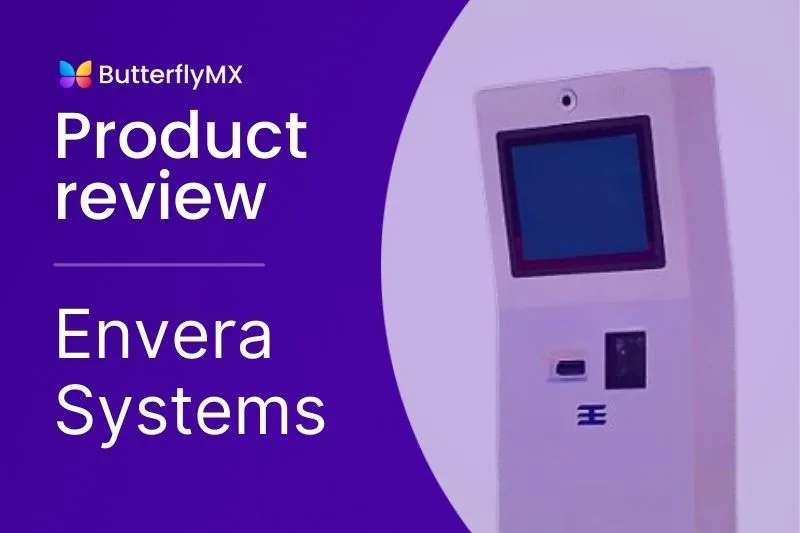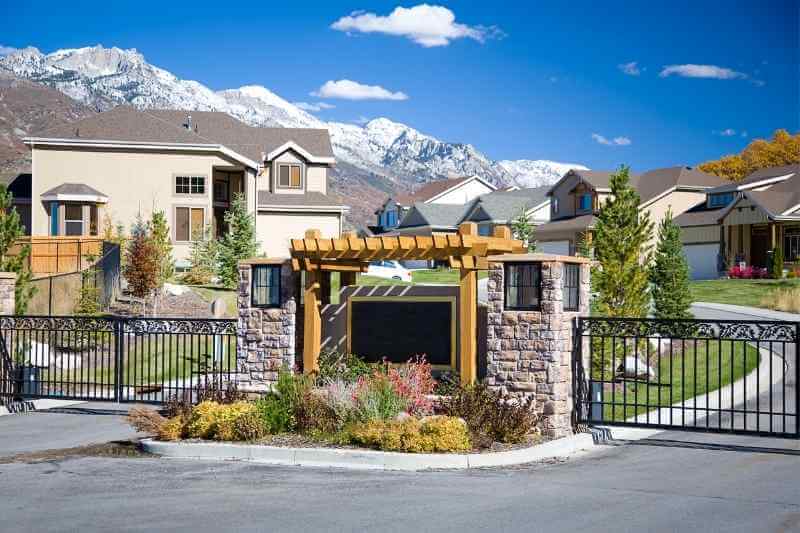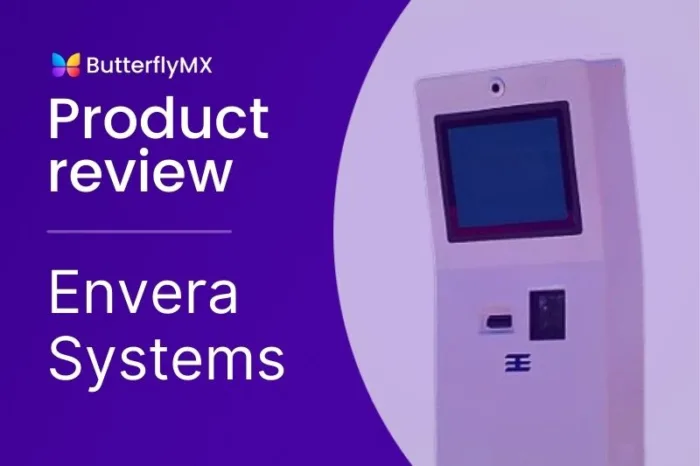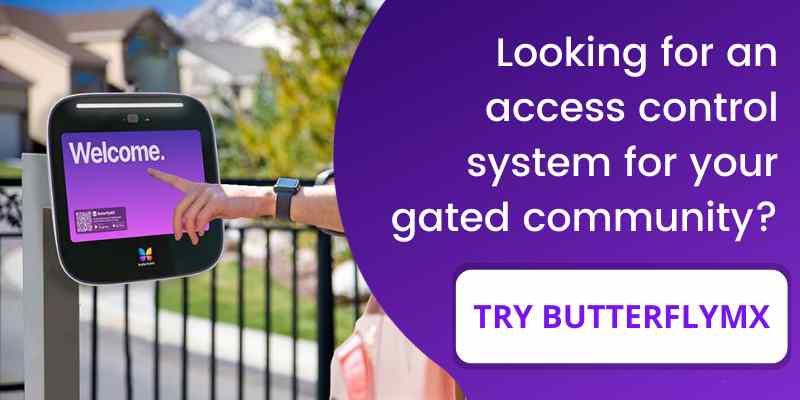Key takeaways
- Envera Systems specializes in remote security solutions for gated communities, replacing or supplementing on-site guards with virtual monitoring and verification technology.
- Customer reviews indicate frequent issues with Envera’s system reliability, slow response times, and high service costs, making it a potentially frustrating option for property managers and residents.
- The Virtual Gate Guard is Envera’s flagship product, using kiosks, license plate recognition, and remote attendants to verify visitor access.
- ButterflyMX offers a more modern, integrated access control experience with vehicle readers, app-based unlocks, and a user-friendly design that eliminates reliance on external operators.

When shopping for a gate access control system, it can get overwhelming to find all the features and specifics about potential products. In this post, we’ll simplify the buying process by reviewing gate access solutions from Envera Systems and what you should know about their products.
If you’re looking for the best gated entry system, it’s our hope that you find our review educational and easy to understand. In the end, you should have a clear idea of the best choice for your access control needs.
In this post, you’ll discover:
- About Envera Systems
- Envera Systems products and services
- Envera Systems cost
- Pros and cons of Envera Systems
- Envera Systems customer reviews
- Types of gate security systems
- Comparison of Envera Systems and ButterflyMX
About Envera Systems
Established in 2007 and headquartered in Coconut Creek, Florida, Envera Systems specializes in remote security solutions for gated communities and residential developments. The company positions itself as a leader in gated community access control, offering a combination of virtual guards, surveillance systems, and access management technology to enhance property security.
What sets Envera apart is its Virtual Gate Guard, which replaces or supplements on-site security personnel with remote monitoring and verification technology. Rather than employing physical guards at every entrance, Envera uses kiosks, license plate recognition, and live remote attendants to control access, aiming to provide a more cost-effective alternative to traditional security staffing.
Who Envera serves
Envera primarily caters to residential communities that require automated yet monitored access control to improve security without the high cost of full-time, on-site guards.
- Homeowners associations (HOAs) seeking a secure but affordable gate entry system.
- Condo associations needing controlled visitor and resident access.
- Community developers designing security infrastructure for new developments.
- Property managers managing multi-entry properties with automated security.
- Residential developers implementing scalable security solutions for growing communities.
Full-service security provider
Unlike some access control providers that only offer access control hardware or software, Envera is a full-service company.
Envera advertises its services as handling:
- Implementation & installation. Setting up gates, kiosks, and security cameras.
- Equipment servicing & maintenance. Providing ongoing support and repairs.
- Monitoring & management. Offering 24/7 virtual guard oversight.
They aim to offer communities a more streamlined, centralized approach to access control and surveillance by combining remote monitoring with physical security systems.
Envera Systems products & services
Envera Systems offers a suite of remote security solutions designed for gated communities. Their core products and services focus on automating visitor entry, controlling resident access, and monitoring property security through a combination of virtual guards, surveillance, and physical barriers. Below is a breakdown of their key offerings, along with benefits and potential drawbacks.
Envera Systems products include:
Virtual Gate Guard
The Virtual Gate Guard is Envera’s flagship product, designed to replace or supplement on-site security guards. Instead of a manned guardhouse, visitors interact with an ATM-style kiosk equipped with a driver’s license scanner, a high-definition camera, and two-way audio communication with Envera’s remote security personnel. The system verifies visitor credentials and determines whether access is granted based on pre-approved guest lists.
Communities can choose between two verification methods:
- Driver’s License Recognition. The kiosk scans a visitor’s ID, checking it against a database of pre-approved guests. If not pre-approved, a live virtual guard contacts the resident for confirmation.
- License Plate Recognition (LPR). Cameras scan license plates and automatically open the gate for registered vehicles, while unrecognized vehicles require additional verification.
Key benefits
- Cost savings. Reduces expenses compared to employing full-time, on-site security guards.
- Scalability. Can be deployed at multiple entry points with a single remote team monitoring them.
Drawbacks
- Delays for unregistered guests. If a visitor isn’t pre-approved, there may be longer wait times for verification.
- Reliance on remote guards. Entry approval depends on operator response time, which varies.
- Technical malfunctions. If the system experiences connectivity issues or scanner failures, gates may remain stuck open or inoperable.

Access control system
Envera’s access control system allows residents, staff, and vendors to enter gates, doors, or shared amenities using secure credentials rather than relying on a security guard. This is an important feature for HOAs and condo associations that must manage who can enter the community’s facilities.
Key benefits
- Supports multiple access methods. Residents can enter using key fobs & key cards, windshield stickers, and biometric readers.
- Remote access management. Property managers can add or revoke access instantly via Envera’s web portal.
- Integration. Works alongside Envera’s Virtual Gate Guard and other security systems.
Drawbacks
- Lacks mobile-first access. Unlike ButterflyMX’s smartphone-based entry, Envera does not emphasize app-based keyless entry, which may be a limitation for modern multifamily properties.
- Potential credential management issues. Losing or replacing key fobs/cards may require property manager intervention rather than self-service solutions.
Video surveillance
Envera offers two levels of video security to enhance community safety.
Active video surveillance
- Live guards monitor camera feeds and can intervene if suspicious activity is detected.
- If an unauthorized person is spotted, Envera’s team can use two-way audio (“voicing down”) to issue a verbal warning and deter trespassers.
- Primarily used in high-risk areas, such as pools, clubhouses, or parking lots after hours.
Passive video surveillance
- Cameras record 24/7 but are not actively monitored in real-time.
- Useful for investigating past incidents, such as vandalism or break-ins.
- Footage retrieval services are available, allowing property managers to request security clips.
Drawbacks
- Active monitoring depends on remote guard attentiveness. If an incident occurs quickly, the response may be delayed.
- System reliability concerns. Some users report downtime or connectivity issues, which can affect recording quality.
- Video retrieval fees. If footage is needed for an investigation, communities may need to pay additional costs.
Barrier gates
Barrier gates provide a physical security layer that helps prevent unauthorized vehicles from entering gated communities. These gates are often used alongside access control systems and the Virtual Gate Guard.
Key features
- Tailgating prevention. Gates close immediately after a vehicle passes to prevent unauthorized cars from sneaking in.
- High-speed operation. Opens and closes in seconds to ensure smooth traffic flow.
- Breakaway arm technology. If a vehicle forces entry, the gate arm can detach safely to prevent major damage.
Drawbacks
- Mechanical malfunctions. If the gate fails, residents may experience long wait times or complete entry lockouts.
- Costly repairs. If a driver damages the gate, communities may need to cover repair expenses unless insurance policies apply.
Additional services
MyEnvera Portal & mobile app
- Residents can pre-register guests to streamline visitor entry.
- Property managers can adjust access permissions remotely.
- Provides entry logs for security auditing.
Central monitoring & video retrieval
- 24/7 monitoring by Envera’s remote security personnel.
- Ability to review and retrieve past security footage for incidents.
- Customizable service plans for different property sizes and security needs.
Drawbacks
- Inconsistent response times. Some communities report that Envera’s customer service is slow to resolve issues.
- Technical failures impact service. If Envera’s central system experiences downtime, access control and monitoring services may be disrupted.
Envera Systems cost
Envera Systems offers custom pricing based on each community’s unique security needs, which means costs can vary significantly depending on the number of entry points, type of access control, and level of monitoring required. Since Envera does not publish pricing details online, most property managers must request a quote directly from their sales team.
However, reported costs from various communities and case studies provide insight into how much HOAs and property managers typically pay for Envera’s services. Below is a breakdown of estimated pricing for each of Envera’s core offerings.
Estimated pricing:
Virtual Gate Guard
- Annual service cost: Upwards of $15,000 for a community with multiple gates.
- Included features:
- Installation and leasing of necessary equipment, such as kiosks and cameras.
- Ongoing virtual guard monitoring services.
Access control system
- Pricing structure: Custom-quoted based on specific community needs.
- Potential costs:
- Hardware: Starts at approximately $1,500 per entry point, depending on the type of access control devices selected (e.g., key cards, fobs, biometric readers).
- Software and maintenance: Additional fees may apply for system management and support services.
Video surveillance
- Passive video surveillance:
- Camera hardware: Estimated to be as high as $300 and $1,000 per camera, varying by specifications and installation requirements.
- Footage retrieval: Services may be billed at up to $50 per hour for video retrieval and review.
- Active video surveillance:
- Monitoring fees: Higher monthly costs per camera or monitored area, reflecting the added service of live monitoring and immediate response capabilities.
Barrier gates
- Installation costs: Typically integrated into the overall security contract.
- Estimated expenses:
- Gate installations: Can start at up to $10,000, depending on the complexity and features of the gate system.
Additional considerations
- Repair and maintenance:
- Standard service: Reportedly billed at up to $185 per hour during regular business hours, with an additional trip charge of up to $60.
- After-hours & emergency service: Rates reportedly increase to up to $195 per hour, plus the trip charge.
Note: All pricing information is approximate and subject to change based on specific community requirements, geographic location, and the scope of services selected. For precise and up-to-date pricing, we recommend that you contact Envera Systems directly for a tailored quote
Learn how ButterflyMX controls access at gated properties:
Pros and cons of Envera Systems
Choosing an access control system for your gated community or property is a major decision, and weighing the pros and cons of Envera Systems is essential to making an informed choice. Below, we break down the advantages and potential drawbacks of using Envera’s access control, video surveillance, and virtual guard services.
Pros of Envera Systems
Multiple access control options
Envera provides a range of access solutions, including Virtual Gate Guard, key fobs, RFID windshield stickers, and biometric readers. This gives property managers flexibility in choosing the best method for their community’s needs.
Reduces the need for full-time security staff
The Virtual Gate Guard allows communities to cut costs on 24/7 security staffing while still maintaining visitor verification. This can result in significant annual savings compared to employing on-site security guards.
Faster visitor verification with driver’s license and license plate recognition (LPR)
Visitors can check in via a self-service kiosk using driver’s license scanners or license plate recognition technology, which can speed up guest entry — especially for pre-registered visitors.
MyEnvera mobile app for remote management
Property managers can use the MyEnvera mobile app to pre-register guests, manage access permissions, and review security logs, making system management more convenient and mobile-friendly.
Full-service provider
Unlike some access control companies that require third-party vendors, Envera handles installation, maintenance, and monitoring in-house, creating a one-stop solution for security needs.
Barrier gates improve security by preventing tailgating
Barrier gates add a physical security layer, reducing the risk of unauthorized vehicles tailgating residents through the gate. They also capture entry data for audit purposes.
Cons of Envera Systems
Video surveillance options may be limited
Envera offers both active and passive video surveillance, but some communities report delays in guard response times for live monitoring. Passive recording means incidents are only reviewed after they occur, which may not be ideal for communities wanting real-time intervention.
Limited mobile-based access for residents
While the MyEnvera app allows guest management, residents may not be able to unlock doors and gates using their smartphones, unlike some more modern access control solutions that offer mobile credentialing for seamless entry.
License plate recognition (LPR) systems require advance knowledge of visitor plates
While LPR cameras can automate access, they require visitors’ plate numbers to be pre-registered, which isn’t always possible. Additionally, some guests may be uncomfortable providing their driver’s license information at the kiosk.
One-way video calling may limit resident control
Unlike some video intercom systems that allow two-way video calling, Envera’s virtual guards see the visitor, but residents may only receive audio communication, limiting visual verification from the resident’s side.
Barrier gates may impact community aesthetics
Some communities find Envera’s barrier gates with LED lighting to be visually unappealing, as they may not blend well with high-end residential aesthetics.
Remote guards may not be familiar with your property
Since Envera’s virtual guards work remotely, they do not have on-the-ground knowledge of your community, which could impact their ability to make quick, informed decisions during security incidents.
Dependence on Envera’s system and data management
Since Envera controls access credentials and security records, communities rely entirely on Envera for system maintenance and management. If a property chooses to discontinue Envera’s service, transitioning to a new system could be complex and costly.
Browser-based software may be less stable than dedicated mobile solutions
Some HOAs report that Envera’s browser-based management platform can be less intuitive and less stable than modern mobile-based solutions, which offer a smoother, more reliable user experience.
Gate malfunctions can cause long wait times
If an Envera-controlled gate malfunctions, there is no on-site security staff to override the system manually, leading to long delays for residents and visitors while waiting for remote support.
Limited integrations with other security solutions
Envera’s systems are not as open-ended as some cloud-based access control solutions that integrate seamlessly with smart locks, video intercoms, and other security platforms. This could be a limiting factor for communities looking for custom security configurations.
Envera Systems customer reviews
Envera Systems provides a comprehensive security solution for gated communities, offering remote monitoring, visitor management, and video surveillance. Their Virtual Gate Guard and active monitoring options are valuable alternatives to traditional on-site security guards.
However, certain limitations — such as reliance on remote verification, potential system failures, and lack of mobile-first access — may be drawbacks for some properties.
What customers are saying about Envera Systems
While every company claims to offer exceptional service, real customer reviews provide an unfiltered look at user experiences. Feedback from actual residents, property managers, and HOA boards can highlight common strengths and recurring issues with a security provider.
On platforms like Yelp and the Better Business Bureau (BBB), Envera Systems currently holds an average rating of 1 out of 5 stars, with many customers citing concerns about system reliability, customer service response times, and gate malfunctions.
Below are some quotes from Envera users that shed light on their experiences:*
“Guests on my visitors list are being denied entry and I am not receiving any phone calls in order for me to verify them. On top of that my guests are being told that I am being called. I’ve already checked my information, which is all correct. Also there is supposed to be 24/7 service, yet I can’t seem to get anyone on the phone when I called this evening. I wasn’t even put on hold, just prompted me to leave a message.” – BBB Customer Review
“My elderly parents live in a gated community secured by Envera. I am a frequent visitor. Every visit we spend approx 10 minutes at the gate. The human beings who had manned the gate were light-years more efficient.” – BBB Customer Review
“It has been three weeks without their services and no fix insight. Our community just went with them and they have no fix to the timing of having their system back up and running.” – JR. S, Miami, FL, via Yelp
“Probably the worst community security I have ever experienced. Zero customer service and the equipment is constantly malfunctioning. HORRIBLE.” – Kari L., Orlando, FL, via Yelp
*Quotes have been edited for length and/or clarity.
Types of gate security systems
Before comparing Envera Systems directly to other access control providers, it’s important to understand the different types of gate security systems available. Whether a community is looking for a physical guard presence, a self-service solution, or a hybrid approach, the right choice depends on budget, security level, and ease of use.
Let’s explore the four main types of visitor management and gated entry systems:
- On-site security guards
- Self-service kiosks & telephone entry systems
- Virtual guard systems
- Hybrid security solutions
On-site security guards
This is the most traditional and thorough security measure, involving live guards stationed at a gatehouse to check in visitors, verify credentials, and monitor traffic. Guards may also patrol the property and handle security incidents in real-time. Many HOAs or gated communities hire security companies to provide this service, often integrating visitor management systems, access control, and license plate recognition (LPR) for added security.
Typical cost:
- A 24/7 guard service costs between $175,000 and $220,000 per year, depending on the provider and location.
- Additional costs may include a guardhouse structure ($36,000) and electronic hardware installation ($45,000).
Pros:
- Physical presence deters crime. Having trained security staff at the entrance creates a strong deterrent against unauthorized visitors and potential intruders.
- Concierge-style service. Guards provide a high-end feel, offering visitor assistance, package handling, and resident support.
- Flexible security protocols. Communities can implement custom procedures, such as manual visitor verification, vehicle screening, and direct interaction with law enforcement.
Cons:
- Very expensive. A 24/7 guard force is one of the highest-cost security options for HOAs and property managers.
- High turnover rates. The security industry has high employee turnover, which can lead to inconsistencies in service quality.
- Visitor inconvenience. Manual check-ins can create delays and long lines at peak times.
- Human error. Guards may overlook security threats or allow unauthorized guests through based on verbal persuasion.
Self-service kiosks & telephone entry systems
Instead of live guards, self-service kiosks and telephone entry systems provide an automated check-in process. Visitors enter a code, scan a QR pass, or use a call box to request entry. Many modern systems also integrate access control, vehicle detection, and LPR to enhance security.
Typical cost:
- $1,500 to $8,000 per unit, depending on the features.
- Monthly subscription fees for cloud-based visitor management software (typically $20-$100/month per unit).
Pros:
- Cost-effective. A fraction of the price of hiring on-site guards, making it an affordable long-term solution.
- Quick and convenient. Visitors can enter quickly using pre-programmed credentials, QR codes, or phone-based access.
- Minimal staffing required. Reduces the need for on-site personnel, lowering labor costs.
Cons:
- Not as secure as human verification. If credentials are shared, unauthorized visitors can enter easily.
- Technical malfunctions. If the kiosk malfunctions or loses connectivity, residents and visitors could be locked out.
- Limited integration. Some older intercom models don’t support license plate recognition (LPR) or advanced visitor tracking.
Virtual guard systems
A Virtual Guard System functions like a remote security checkpoint. Visitors interact with a live, off-site security guard via a kiosk with two-way audio and video. Guards verify visitor credentials, review vehicle data (using license plate recognition and access control logs), and manually grant or deny entry.
Companies like Envera Systems specialize in this type of security, staffing a remote operations center where guards monitor multiple properties at once.
Typical cost:
- $70,000+ per year for a full-service virtual gate guard solution (including kiosk equipment, monitoring, and maintenance).
- More affordable than 24/7 on-site guards but pricier than self-service intercoms.
Pros:
- More secure than self-service kiosks. Virtual guards add human oversight without the high cost of full-time staffing.
- Cost-effective compared to on-site guards. Can save HOAs $100K+ per year compared to full-time guards.
- Improves security infrastructure. Virtual guard systems integrate with LPR, visitor logs, and cloud-based access control for a smarter entry process.
Cons:
- Dependent on technology. If the kiosk malfunctions or loses connection, visitor verification may be delayed.
- More expensive than self-service options. Costs more than traditional telephone entry or intercom systems.
- Guards do not have on-the-ground knowledge. Remote operators may not be familiar with property-specific concerns or past security issues.
Hybrid security solutions
A hybrid system allows communities to customize their gate security setup, combining elements of on-site guards, self-service kiosks, and virtual guard monitoring.
For example, a property might:
- Use on-site guards during peak hours and switch to virtual guards overnight.
- Install self-service kiosks at secondary entrances while keeping a main entry staffed.
- Implement LPR cameras and mobile access control alongside a remote monitoring service for added security.
Typical cost:
- Costs vary widely depending on the level of security customization.
- More affordable than full-time staffing, but costs can increase with additional technology and integrations.
Pros:
- Customizable & flexible. HOAs and property managers choose which security elements fit their needs.
- Balances cost and security. Can reduce labor costs while maintaining human oversight where needed.
- Integrates multiple technologies. Hybrid solutions can incorporate virtual guards, smart access control, LPR, and intercoms for seamless security.
Cons:
- Can be complex to manage. A disjointed system may require multiple vendors and platforms to function properly.
- Higher setup costs. While more cost-effective than full-time guards, initial installation and integration of multiple systems can be expensive.
Comparison of Envera Systems and ButterflyMX
Both Envera Systems and ButterflyMX offer solutions for gated property access control, but they take very different approaches. Envera relies on remote guards, expensive hardware, and pre-registration requirements, whereas ButterflyMX provides a seamless, resident-driven experience with a cloud-based, mobile-friendly system. Below is a side-by-side comparison of the two, focusing on pricing, customer service, and reliability.
Pricing
Envera Systems
- Custom pricing model based on property size, number of gates, and level of monitoring required.
- Significant upfront costs for cameras, license plate readers, and virtual gate kiosks.
- Recurring monitoring fees for off-site virtual guards.
- Costs can increase with additional visitor verification services, equipment maintenance, and remote guard staffing.
ButterflyMX
- Transparent, subscription-based pricing model.
- No costly virtual guard staffing. Instead, residents and property managers can control access directly through the mobile app or the OS.
- Scales efficiently for properties with multiple access points, including gates, doors, garages, and amenity spaces.
Customer Service
Envera Systems
- Customer reviews on Yelp and BBB average 1 out of 5 stars, with common complaints about slow response times and gate malfunctions not being addressed promptly.
- Frequent issues reported with remote guards, including missed verification calls, incorrect visitor approvals, and system downtime.
- Lack of real-time resident control, meaning residents must depend on Envera’s off-site staff to approve visitors and deliveries.
ButterflyMX
- Highly rated for customer service, with property managers praising its user-friendly interface and fast troubleshooting support.
- Mobile-first design allows residents and staff to manage access instantly, reducing reliance on external support.
- Seamless integrations with other security solutions, such as keypads, fobs, and vehicle readers, providing a frictionless user experience.
Reliability
Envera Systems
- Heavily reliant on virtual guards and internet connectivity. So, if there’s a technical failure, gates may not function properly.
- Some communities report frequent technical issues, including gates being stuck open, delayed visitor verification, and system outages.
- Residents have no direct control over their guest approvals; they must wait for a remote guard to process the request.
ButterflyMX
- The cloud-based, app-controlled system reduces mechanical failures and operates even if property staff are unavailable.
- Fewer moving parts compared to Envera’s gate kiosks and scanners, leading to fewer service interruptions.
- Residents can manage access remotely, ensuring that guests, deliveries, and service providers can enter without unnecessary delays.
Here’s how the features of ButterflyMX and Envera Systems compare:
ButterflyMX vs. Envera Systems
Envera Systems offers a multi-faceted gate and visitor access management solution for gated properties. However, Envera relies on expensive technologies and off-site “guards”, which doesn’t give residents enough power or flexibility to manage their visitors and deliveries seamlessly.
In contrast, ButterflyMX offers a powerful unified property access control solution that effectively controls access both at your front gate and other access points throughout the property. With cloud-based software and a powerful mobile app, residents and property staff can do everything on the go.
If your community prioritizes convenience, scalability, and a resident-friendly experience, ButterflyMX is the clear choice. It eliminates the delays, costly virtual guards, and rigid visitor verification processes that can frustrate both property managers and residents.
Here’s a closer look at the key differences between Envera Systems and ButterflyMX:
- Mobile app. Both ButterflyMX and Envera offer mobile apps and smartphone use. However, ButterflyMX offers the ability to unlock gates and doors by just swiping in the mobile app. Envera’s app may not provide any quick door-opening methods.
- Video intercom. While Envera’s video surveillance system may be useful, ButterflyMX offers a two-in-one Video Intercom that controls access and takes a photo of every entry event for added security. Plus, the ButterflyMX Video Intercom doesn’t require in-unit hardware or property-wide wiring and allows residents to vet visitors and manage access themselves rather than relying on third-party call center workers.
- Visitor access solutions. While Envera offers license plate and driver’s license reader solutions for visitors, they require residents to register visitors ahead of time. When a visitor arrives, an off-site guard still has to review the visitor’s credentials and approve access. In contrast, ButterflyMX empowers residents to share Visitor Passes with visitors so they can quickly gain access without residents having to manually let them in.
- Vehicle readers. ButterflyMX offers Vehicle Readers and Windshield Stickers that identify registered tenants’ vehicles. But visitor access is still simple because guests can quickly scan a Visitor Pass or request access via video call. Alternately, Envera’s license plate reader relies on license plate numbers and requires residents to register every visitor in advance. This limits visitor access and creates more work for property managers, HOA boards, and condo associations.
Disclaimer: ButterflyMX provides these blog posts to help our customers and potential customers make the right business decisions for them. Our blog posts are based on the information we have available to us at the time of writing.

Get your free quote!
Fill in the form below, and we'll email you right back.
Want a free quote?
Fill in the form below, and we'll email you right back.
You’ll be redirected shortly...






